| |
CLICK ON ANY IMAGE TO GET THE BIGGER PICTURE
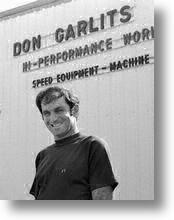
The Man himself pictured in 1971
|
For a website dedicated to the history of drag racing,
there can be no greater honour than to have "Big Daddy" Don Garlits
join our distinguished list of contributors. This unique opportunity to
welcome The King of the Dragsters to The Acceleration Archive has been made
possible thanks to the photo collection of ace snapper Roger Phillips, who to our
good fortune visited 'Big Daddy' at a very pivotal moment in the history of the
sport. The date was November 1971 and the world of drag racing had been turned
on its head by the debut of Don's “revolutionary” rear-engined dragster earlier
the same year. As is now legend, this fundamental change in dragster design came
about after Don had suffered an horrific transmission explosion that cut his
slingshot dragster - and his foot - in half at Lions Dragstrip in March 1970.
Vowing to never sit behind an engine again, Don drew up his ideas for a
rear-engined configuration while recovering in hospital. The cynics said it
wouldn’t work but it didn’t need history to prove them wrong . . . Don’s
rear-engined Top Fuel car was an immediate success and the bells soon tolled
for the slingshot dragster. Suffice to say, all these years later no other such
elementary change to dragster design has usurped the revolution that Don
Garlits brought to Top Fuel racing.
Whilst Roger Phillips photographed every nook and
cranny of Don’s Florida Speed Shop back on that late November day in 1971, the
privilege of the visit was not lost on the accompanying group of Brits but only
with the annals of time can we now appreciate its full significance. Naturally
Don Garlits was thrilled to hear we had such a comprehensive photographic
record of his workshop premises during this landmark period, so while Don pored
over the collection, we asked if he would guide us through the photos for
everyone to enjoy.
|
| |
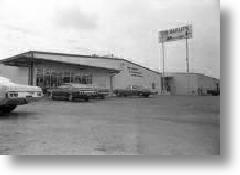
|
Hi there everyone, I
hope you enjoy the tour. Well we were operating from two premises in ’71, the
speed shop which was downtown in Tampa and the machine shop at my home in
Seffner. This is the speed shop, “Hi Performance World Inc.” at 3420 West Main
Street.
|
| |
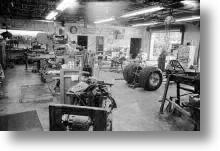
|
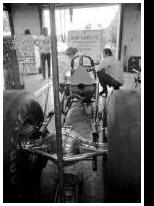 So this was our base in Seffner. This is where we kept the car, ran the chassis business and did all
the engine work. That’s TC in the doorway, the trailer outside and Connie
Swingle talking to the English guy, Mike Lintern. And Swamp Rat 16 in the
foreground. TC and Connie's contribution to getting my rear-engined design to work was important. What’s
interesting here is I can see we were already experimenting with some changes to
the chassis on SR16 and this Swamp Rat was still ‘brand new’! So this was our base in Seffner. This is where we kept the car, ran the chassis business and did all
the engine work. That’s TC in the doorway, the trailer outside and Connie
Swingle talking to the English guy, Mike Lintern. And Swamp Rat 16 in the
foreground. TC and Connie's contribution to getting my rear-engined design to work was important. What’s
interesting here is I can see we were already experimenting with some changes to
the chassis on SR16 and this Swamp Rat was still ‘brand new’!
|
| |
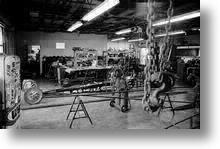
|
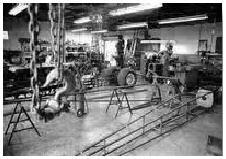 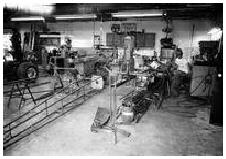
Left and above - A view of the shop
from another angle, the chassis jig and Connie on the far right.
|
| |
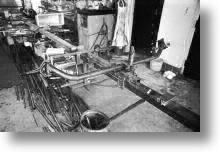
|
That is the jig we
used to build the original rear-engine dragster, Swamp Rat 14. That front axle
looks wide by today’s standards but that’s how wide the Top Fuel front axles
were back then. And you’ll notice the spindles we were using, same as an Anglia
front wheel spindle but they were after-market items.
|
| |
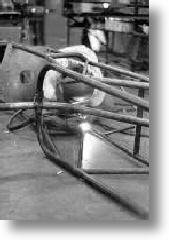
|
The man behind the
mask is Connie Swingle. We were turning out about a chassis a month in ’71, at
$1500 each. Tom McEwen, Art Malone, Chris Karamesines, Earl Binns, Jim Walther,
those are some of the names I recall who bought one of our chassis.
|
| |
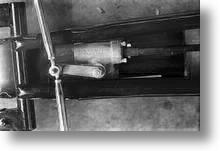
|
Here is the steering
box. We shortened that armature that you’re looking at right there, to slow
down the steering, and lengthened the arms out on the spindles. When we had built SR14 we figured out the steering was too fast and needed to slow it down. That was the
key to getting the rear engine dragster to work and stop it darting around when
the front end got light at the top end.
|
| |
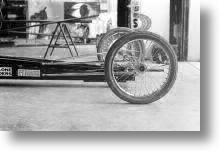
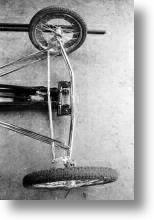
|
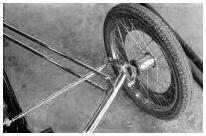 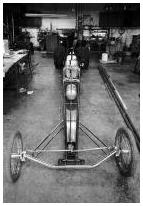
Left and above - I can’t believe I let
Roger Phillips take pictures like this! These show the off-set front axle,
fairly visible isn’t it? I didn’t like people taking photos like that then
because it would get our secrets out. The offset was about 4” and Swingle bent
up the special axle. We had to have more roll out, when in stage, because we
were getting redlights on the 5/10ths xmas tree and they hadn’t changed to four
yet. Andy Barrack tells me that in my original 1971 interview with Mike Lintern
I said a couple of West Coast guys came up with the off-set idea, but I don’t
remember that – but I am 74 years old and forgetting a few things!
|
| |
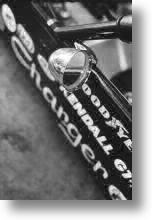 |
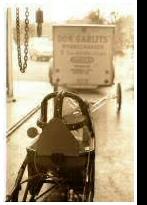 The rear view mirrors were to watch the engine but most
especially to see where the crew is, because some guys had been run over like
Clayton Harris, by the guy making the burnout before the crew guy was clear
pouring the bleach. There should be a mirror on both sides, the right hand
mirror must have got knocked off in the shop, the guys were always doing that
kind of stuff. We had mirrors on both sides always. The rear view mirrors were to watch the engine but most
especially to see where the crew is, because some guys had been run over like
Clayton Harris, by the guy making the burnout before the crew guy was clear
pouring the bleach. There should be a mirror on both sides, the right hand
mirror must have got knocked off in the shop, the guys were always doing that
kind of stuff. We had mirrors on both sides always.
(Clayton
Harris was actually injured at the 1973 Grandnationals when he was hit by
fellow TF driver Charlie Moulder. Harris was helping out on Moulder’s car when
he was struck during a pre-stage misunderstanding between crew and driver. In a
tragic twist of fate, former Garlits’ crew chief Herb Parks was run over and
killed in 1988 in a similar pre-stage mishap while crewing for Rocky Epperly at
Desoto Memorial Speedway in Bradenton Florida. Parks had worked for Don for
nearly ten years, beginning in 1976.)
|
| |
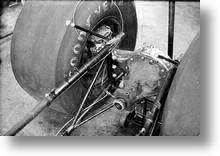
|
That’s a Dodge 8¾ rear end. At this time I ran an open rear
end. No spool or posis. Of course that later changed. A posis, or limited slip
differential, was dangerous because sometimes it worked, sometimes it didn’t, and
when it didn’t you could be in serious trouble - into the next lane or worse.
Most of the other guys ran spools but we were running an open rear end.
|
| |
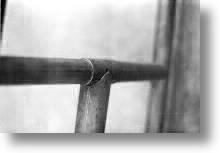 |
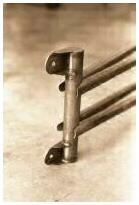 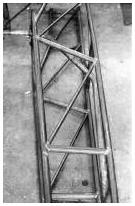 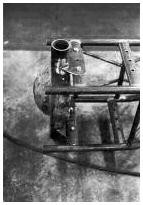
Left and above - Here’s some other shots of the chassis Connie is working on.
In the first photo that’s a slip joint we used way back then which is now
standard in the industry. It allows the frame to flex better and the weld is
not directly on the supporting tube, it’s on the tube that slips so you don’t
have the heat in the supporting tube, which weakens it. In the second photo you
see it wasn’t necessary to have a torsion bar – which was usual back then - the
chassis had become so flexible that it did all the work. We were the first ones
to do that and that’s now standard, there’s no suspension on any of today’s Top
Fuel cars.
What interests me about the fourth photo is if you take a
good look, that has had the rear end moved back, you can see the first mount
there which wasn’t used. I don’t know what that deal was, I can see I had done
that but I don’t know why . . .
|
| |
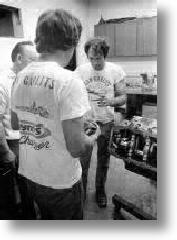
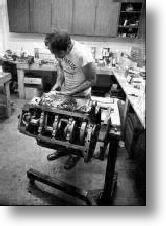
|
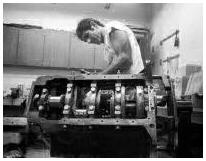 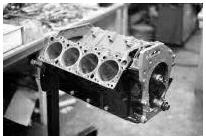
Left and above - We were doing some
outside work, building engines for other racers, then when we later moved
everything to the shop in Tampa and did even more. That’s Bob Phelps and Mike
McKissack with me in the engine room. We sold an engine to Phelps for his
British fueler (Firefly). The right hand photo shows the 426 with the KB short
cover on it. We had to use that in those days to push the blower belt real
close to the engine because we wanted the cockpit to be as far back and as
close to the engine as possible as we were trying to get all the weight on the
rear wheels. And so we used that KB system; Keith Black designed that whole
deal, the timing cover and the timing gears and the pulley run right against
that cover.
|
| |
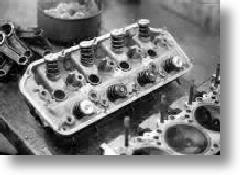
|
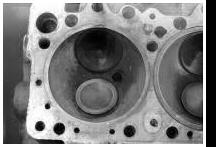 Those are the 426 cylinder heads, the very early NASCAR
model. In the left photo, if you notice up in the upper right hand corner that little kind of a
scallop instead of a straight corner. That little scallop was to clear the
distributor and that’s the early single plug NASCAR head and we used them
exclusively. They had water in them and actually it was like a governor, the
minute that the valve clearance on the exhaust went away you knew you couldn’t
put anymore nitro in it. Too much nitro resulted in too much heat, and too much
heat and the valve would start to melt and sink into the combustion chamber. If
the valve clearance became too tight the valve would fail. That’s all the nitro
they could take. Today they have the billet aluminium heads with no water
jackets and you can do whatever you want to them - no “hot spots” and with
titanium valves - you just blow the whole bottom of the engine out instead . . . Those are the 426 cylinder heads, the very early NASCAR
model. In the left photo, if you notice up in the upper right hand corner that little kind of a
scallop instead of a straight corner. That little scallop was to clear the
distributor and that’s the early single plug NASCAR head and we used them
exclusively. They had water in them and actually it was like a governor, the
minute that the valve clearance on the exhaust went away you knew you couldn’t
put anymore nitro in it. Too much nitro resulted in too much heat, and too much
heat and the valve would start to melt and sink into the combustion chamber. If
the valve clearance became too tight the valve would fail. That’s all the nitro
they could take. Today they have the billet aluminium heads with no water
jackets and you can do whatever you want to them - no “hot spots” and with
titanium valves - you just blow the whole bottom of the engine out instead . . .
|
| |
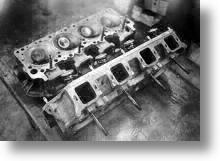 |
We raised the exhaust ports on the 426 heads which later
that became standard. Do you know why those ports originally aimed down; do you
know why Chrysler designed the ports wrong? NHRA said that the engines had to
be installed in the cars on the production line if the car was to compete in
Super Stock. So Chrysler had to re-engineer the engine and put the manifolds
way down low and turn the exhausts so that it could drop in the chassis coming
down the production line. They call it the Wally Park’s Exhaust. They never
forgave NHRA for that. Meanwhile over at Ford they were putting their Super
Stocks together in a tin shed in Detroit.
(NHRA established
the requirements for vehicles to qualify for competition in the Stock and Super
Stock categories and often dispatched personnel to Detroit to verify production
and quantities. With rivalry in Detroit as it was in the late '60s and early
'70s for the 'muscle car' market, and drag racing an ideal showcase for the
cars, one informed source recalls the manufacturers were known to assemble high
performance cars in “tin sheds” and then ship them over to the factory assembly
line for verification. Needless to say these “tin shed” production models were
blueprinted to the max and not your standard factory model. NHRA were not
oblivious to such shenanigans and outlawed such 'liberal interpretations' of
their Stock and Super Stock regulations whenever they could.)
|
| |
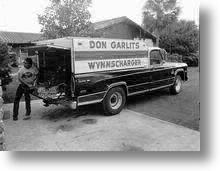
|
Okay, we’re outside the
machine shop now. That’s my home in the background and TC on the tailgate of
the pickup truck. Now make sure you spell TC’s name correctly – it’s TC Lemons
– with one ‘m’. He’ll be really upset if you spell it wrong; they even spelt it
wrong on his damn Car Craft All-Star’s jacket for god’s sake. They gave him
that jacket when he won the All-Star Crewchief award but he just ripped it
apart when he saw they’d written 'Lemmons'. He was mad as hell.
|
| |
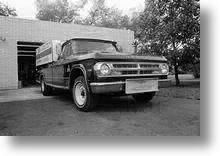
|
That’s our Dodge
Adventurer. Dodge supplied me with free trucks for years and years for all the
work we did. We even took the truck on board the aircraft carrier USS Lexington
when we did the recruiting poster for the US Navy. They just hauled it onto the
flight deck and we spent five days out at sea having a ball. Mike Brenner shot
the poster with SR16 on the launch catapult, it was a famous picture.
|
| |
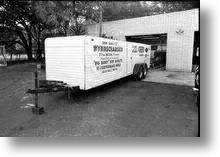
|
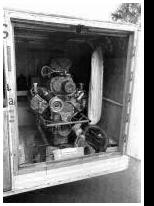 This is the trailer and spare engine. We took the trailer
everywhere, east, west, north . . . match racing kept us on the road all year round,
on top of the AHRA, IHRA, NHRA and booked in races. This is the trailer and spare engine. We took the trailer
everywhere, east, west, north . . . match racing kept us on the road all year round,
on top of the AHRA, IHRA, NHRA and booked in races.
What do they call a full
season now, twenty something races?
We always carried a fully prepared spare engine
but unless there was a catastrophe we didn’t usually need it. It was usually
only the blower and injector we changed if we’d had an explosion. We
wouldn’t use the spare 'as is' unless it was an emergency. This compartment in
the trailer was a nice place to transport the spare engine. We were getting
ready to go to Gainesville for the Turkey Trot Drags when the English guys
turned up to visit me.
|
| |
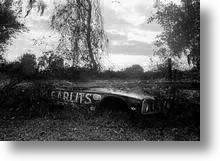
|
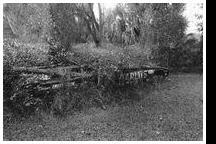 That’s the Funny Car
out behind the machine shop, the Dodge Dart that Emery Cook drove, you can
still see his name on the side. Well this is just the body – the frame didn’t
go outside so we actually repaired that and that’s in the museum. And behind
the vines is the lake where the big alligator resided; we called
him“Reptilious”. He was about fourteen feet long, he’d sun himself on the shore
but he never came up in the yard to get a dog or anything, but if you revved
the motor and it made that vibrating noise, you could get right up next to him.
The noise on his belly must have been like petting a cat or something. That’s the Funny Car
out behind the machine shop, the Dodge Dart that Emery Cook drove, you can
still see his name on the side. Well this is just the body – the frame didn’t
go outside so we actually repaired that and that’s in the museum. And behind
the vines is the lake where the big alligator resided; we called
him“Reptilious”. He was about fourteen feet long, he’d sun himself on the shore
but he never came up in the yard to get a dog or anything, but if you revved
the motor and it made that vibrating noise, you could get right up next to him.
The noise on his belly must have been like petting a cat or something.
|
| |
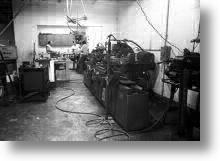
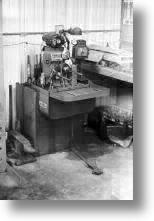
|
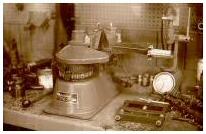 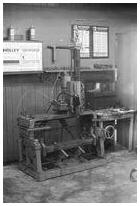 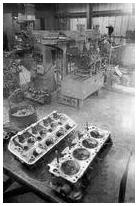
Okay now we’re
looking round the machine-shop. Top left is the crankshaft grinder, we actually
ground our own crankshafts back then. On the left is my Sunnen pin-fitting machine - I
still have that. Then above from left to right a Sunnen machine for surfacing the rods, then the
Quickway Boring Bar, and finally the Tobin Arp machine for line
boring.
|
| |
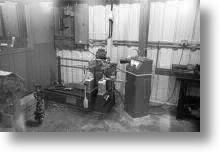
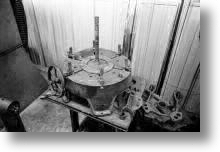
|
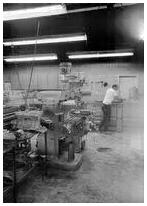 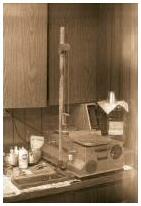 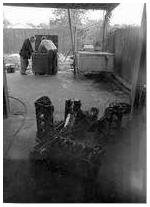
More machines: top left is the
Stewart-Warner balancer, I still have that - it works just fine. Left, that's a very important machine - that's an old clutch machine from the past, which we set our own clutches up on. I still have that. Then above left to right - the Bridgeport, we still have that. The Shadograph balancer for balancing the rods and pistons. And outside to look at
the clean-up area, that’s the cleaning tank on the left and the boiling tank on
the right.
|
| |
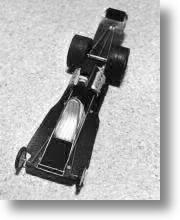
|
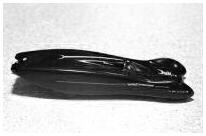 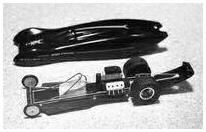
Here’s the scale
model of the Wynns-Liner, Jocko Johnson built that for us and just a week or so
after the visit from the English guys I carried the model to Vietnam to show
the troops - and I brought it back; it is right here in the museum. The model
is about 1/16th scale. There were two things wrong with the Wynns-Liner
basically. We didn’t have carbon fibre yet, the body was way too heavy, you
added about 200 pounds to the car and we didn’t have the horsepower to deal
with that then. Then the front of the car, if you look at it real closely you
see as it gets up to real speed as much air can go under it as can go over it,
and that thing would fly. I drove it at 180mph and it was completely off the
ground, I heard the engine rev up and I thought the drive train had broke. Of
course I lifted immediately and then I felt it land; when the car touched down
I knew what had happened. And that was it, there was no more dealing with it,
that was the last run I made. Jocko vehemently denies that anything like that
could ever happen – but he wasn’t driving it!
|
| |
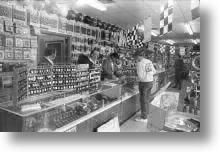
|
Okay we’re back at the Tampa speedshop now. These are the
English guys auditioning as sales clerks at Hi Performance World Inc.
(behind
the counter, left to right Ray Hart (American Automotive), Bob Phelps (Santa Pod
Raceway) and Dick Lawrence (Dick’s Place) with Phil Stentiford acting as
customer)
|
| |
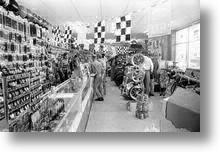
|
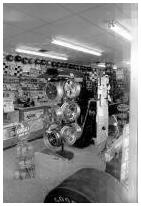 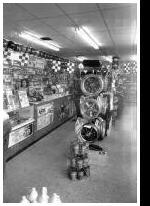
More shots inside the
shop. We later moved the machine shop to this location and also the chassis
business. We still own the premises, but you won’t find ET mags or BRM wheels
there any longer – it’s leased to a silk flower business. The museum is at
Ocala about 80 miles north of here.
|
| |
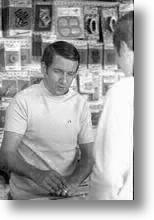
|
There’s Robert
Anderson behind the counter, he was a sales clerk, along with Doug Grunst.
Interesting, we sold Swamp Rat 12a to Robert. Then we found it in Florida
later, it’s never been restored it’s still here in the shop.
|
| |
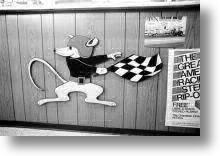
|
That’s 'Swampie' he
was on the front of the speed-shop counter. We still have that, that’s in the
museum.
|
| |
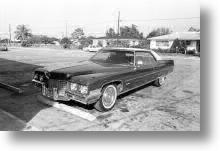
|
That Roger Phillips
photographed everything, even my ’71 Cadillac Coupe de Ville! Actually it was
my wife’s, I better get that right! If Pat had not encouraged me after Swingle and I had built a new car, slingshot #15, following the Lions accident, we would never have completed the rear-engined car project SR#14. Pat told me in no uncertain terms to get back on the RE car and forget the slingshot.
|
| |
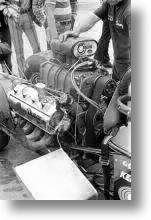
|
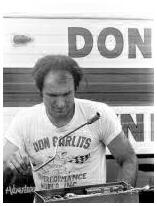 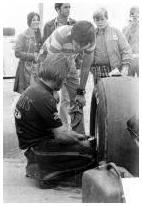 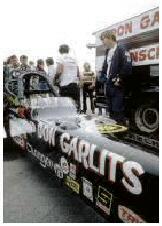
Left and above - Okay we’re finally at
the drags. This was the 3rd Annual Turkey Trot Nationals at Gainesville, the
last weekend in November, 1971.
|
| |
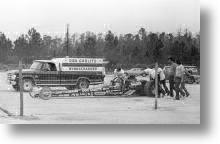
|
Just a bunch of
people helping push car round, getting ready to go. We gathered up guys at the
strip a lot in those days, because there wasn’t much to do to the car between
rounds. Me and TC were the crew, sometimes Connie too, sometimes Mike
McKissack. The extra help you needed was just some muscle to push the car around
and lift stuff. We didn’t have to take heads off back then, and completely
rebuild the car in 75 minutes. Today they’ve carried it to the absurd if you
want to know the truth of the matter.
|
| |
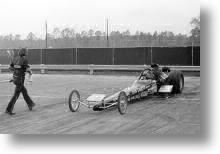
|
In the bleach box
waiting to do the burnout, TC walking over with his bottle of VHT.
|
| |
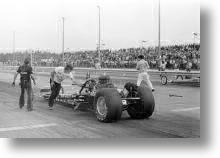
|
Burnout complete Mike
McKissack pushes me back and TC looks on. That’s Dick McFarland in the other
lane. He was from Fort Lauderdale, Florida, but he didn’t run a Garlits
chassis, his was Woody Gilmore. Andy Barrack has done his research and tells me
I matched raced and beat Tommy Ivo on the Saturday night and then knocked out
McFarland, Clayton Harris and Jimmy King to win the event. My quickest ET was a
6.48 and no-one came closer than McFarland’s 6.70. Sounds about right, we were
that far ahead of the competition all that year.
|
| |
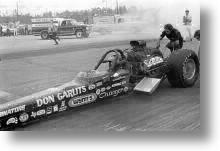
|
You’ll notice
something unusual here, the car has got canard wings on it. That’s because on
our first run that weekend the rear wing collapsed and we almost crashed and we
came home and had to put those canards on the car for the race. We didn’t want
to use the canards but that’s all we had, we couldn’t get another rear wing
that quick. The canards weren’t as good but we got by with them.
|
| |
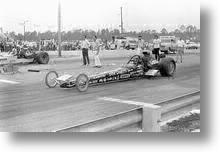
|
Semi final time,
against Clayton Harris. He didn’t have a rear wing either, but I don’t know
why. Clayton and I were friendly but also fierce competitors; we had a few
words from time to time. He had a hot spell in ’72 and set the ET record for a
while. Then he said he was gonna chase me round the country and put me out of
business!
|
| |
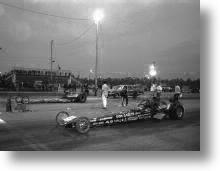
|
This must be the
final, it’s getting dark. Jimmy King in the King & Marshall slingshot, in
the far lane. Jimmy and I are still good friends. The King & Marshall team
are in the Hall Of Fame, and we see them every year, they come to the reunion.
That car has been restored and they take it to The Cacklefest. And of course
Swamp Rat 16 is in the museum at Ocala y’know.
|


![]()